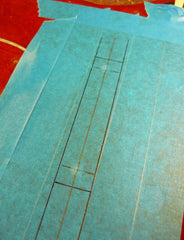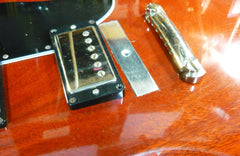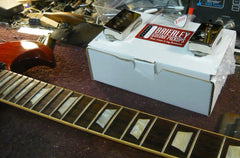Putting a "sustain block" in an SG
Share
I can't say I've fitted heaps of these blocks over the years but I have had enough experience with them and guitars that had them fitted from the factory and the same thing always bugs me. I don't think brass is very good for making the blocks out of .............
I know this runs against popular consensus but I've always found brass to be too "frequency specific" and not in a good way (unless it's really the freq you want ?) and I have personally always preferred aluminium for this job. Most people either klnow sustain blocks as something you mod your Strat "trem" or Floyd Rose with to add sustain. This is usually a heavy metal or brass vibrato block used for adding mass (or weight) to the bridge to add sustain. I don't think they always work (that's another blog) but there has been a big business in the last few years of selling these blocks as production blocks get made of worse and worse quality materials, and have been since the 70's in some cases.
Some Japanese guitars from the 80's had sustain blocks fitted from the factory and manufacturers like Aria and Ibanez played with the idea for years before giving up on working out the holy grail of sustain. My favourite manufacturer Mosrite made a guitar in the 70's called a Brass Rail that had one piece of brass run all the way from the nut to the bridge (including the frets) based on this idea of ultimate sustain. It was an amazing piece of engineering that ultimately didn't catch on.
So, when Ed Kuepper bought his newer SG in for some work and a sustain block, I was kinda shocked ? No-one had asked me for a block in a while and as we discussed the reasons behind it it was obvious Ed wanted a block, but maybe not a brass one ? Ed knows what he wants from his tone and we often discuss the intricacies of it with relation to what can be done. He has a great way of describing what he's after, and then realizing from what I'm saying how we might get closer, and he seems to trust my suggestions. Some people are VERY hard to work with when it comes to "tone" as it's such a subjective thing. Ed's great to work with.

So the SG needed some other slight work but the sustain block was going to be the big one. It would be hard to reverse if it didn't work properly and is one of those "suck it and see" mods that might not yield the results wanted but you don't know until you string it back up ? I'd recommended aluminium to Ed, which he was happy to go with so .............

First thing to do was work out what size block to use. This is as much aesthetics as it is functionality. I didn't want it to stick out like a saw thumb. The theory for me is very similar to the wrap around bridge that Gibson use, which is my all time favourite bridge when set up right. Sure, the extra "mass" is helping (or sometimes hindering, another story) with sustain but I think "joining" the bridge in one piece, joining the posts together with one piece of aluminium to ":complete" the vibration" is what's doing the work here ? It's different to a wrap around, which also has the tension of the strings on the single piece of metal also used as a bridge, but the theory is heading in the same direction. The bridge posts aren't "floating" in grain that technically aren't connected all that well.

The block was cut and the recess made all by hand. It had to be a fairly tight fit as you want the vibrations of the block to transfer out into the body as well as through itself. The recessed threaded hole in the block it to remove the block as you get the fit perfect. Nothing worse than trying to pry a tight, but not yet perfect "thing" out of a hole and damaging the surrounding paint.
With the block right, it was epoxied in with just enough glue to hold it in place. I didn't want a thick layer of glue to "dull" the transfer of vibrations between aluminium and timber.

With everything in it was time to drill the post holes. Aluminium is much less forgiving than timber so you need to be careful drilling anything as it must be spot on, or all this has been a waste of time and would need to be done again.
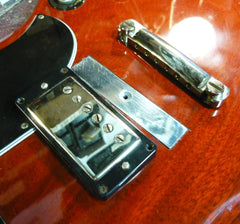
I've seen Gibsons (and most other manufacturers) with the bridge in the wrong position so never assume that where a bridge came from is where a new bridge will go back. For string alignment and intonation, this must be perfect. Tune-o-matics have some room for error as far as intonation goes but getting it exactly right means it will work better and different gauges/tunings won't be an issue if you need that room to move on the saddles.
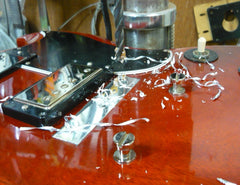
The post ferrules are an interference fit and are usually pushed into the soft timber and the knurls used to hold them in place. With aluminium you need to be a bit more accurate as it won't compress and hold the ferrules in place. Again, I didn't want to use glue to hold these in place.
With everything back in place it was time to fit new pick ups.

It's no secret what a huge fan of Mick's pick ups I am and I've covered pick up replacement many times so I won't bore you with the details here. Ed wanted single coils in this one and Micks B90's are great and like all humbucker sized "P-90's" you don't have to rout or modify the body to suit. So, in they went.

I'm a HUGE fan of the wrapover stringing method on any Gibson that will allow it. The neck angle/bridge height is crucial to this technique working properly, but when it works, I personally think it gives better sustain (which is what all this has been about) and "clearer" tone.
This SG had a decent neck angle and allowed this method but I would have preferred a little more height on that bridge, but hey, I wasn't going to do a neck reset just to get it.

So, how does it sound ?
I played this guitar a bit before doing the mod to try and get a "feel" for it but of course I'm never going to know like the owner who knows the feel and tone inside out. Personally I could tell pretty quickly there was more sustain. It also had more "life" to it. The frequency response seemed more open, there was more attack and reacted nicely to open strumming.
I personally find brass to have more lower mids but at the expense of sustain. I know right ?
It's a hard one to evaluate because all guitars react differently but the greater mass of brass means you need more string energy to "get it moving" and in some cases this causes less sustain. Aluminum is less dense and lighter but still adds that connecting "block" and "mass" under the bridge and I find has a wider freq response with nicer mids and upper mids and a "zing" that brass doesn't have ? I also like the way it reacts with gain and distortion. In the right circumstances it can have harmonics not present in timber which I prefer.
Like all "tone talk", this is all personal of course but I'd take aluminium in guitar manufacturing any day.


